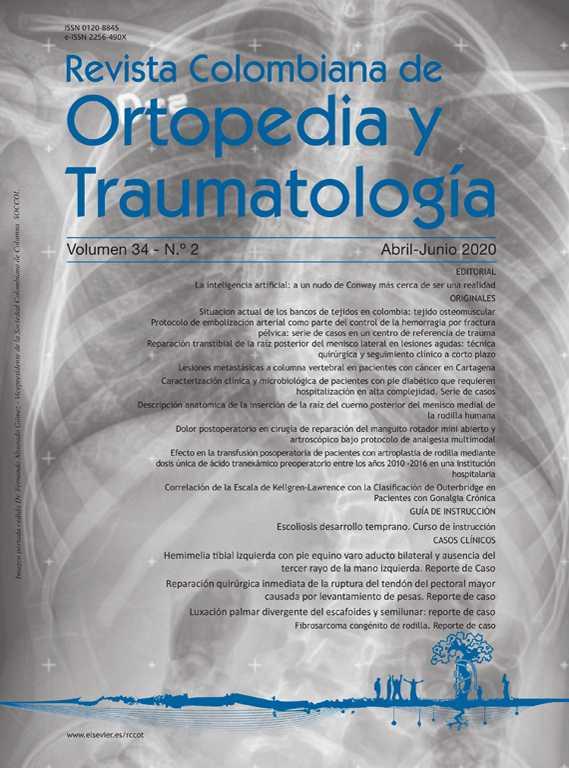Protocolo de embolizacion arterial como parte del control de la hemorragia por fractura pélvica: serie de casos en un centro de referencia de trauma
DOI:
https://doi.org/10.1016/j.rccot.2020.06.004Palabras clave:
fractura pélvica, sangrado pélvico, embolización, pelvisResumen
Introducción: Las fracturas pélvicas se asocian a sangrado arterial y/o venoso, ocasionando mortalidad elevada. El objetivo del estudio es diseñar, implementar y evaluar un protocolo para el tratamiento de fracturas pélvicas
Materiales y métodos: estudio prospectivo observacional, de pacientes con fractura pélvica que ingresaron a la clínica Medical. Variables: edad, sexo, arteria comprometida, lesión unilateral o bilateral, tipo de fractura pélvica (clasificación de Tile), indicación de la arteriografía, acceso uni o bilateral, éxito angiográfico, complicaciones del procedimiento, lesiones asociadas, mortalidad a 30 días, mecanismo de trauma, días de estancia en cuidado intensivo.
Resultados: 56 pacientes con fractura pélvica, 17 pacientes se llevaron a arteriografía pélvica por sospecha de sangrado, 14 pacientes tenían sangrado arterial, promedio de 36 años, las arterias más comúnmente lesionadas fueron la arteria hipogástrica, arteria sacra lateral y la arteria obturatriz. la mayoría de sangrados se asociaron a fracturas tipo C, las lesiones asociadas se encontraron en un 34% de casos, la indicación de la arteriografía fue inestabilidad hemodinámica al momento del ingreso, el control del sangrado se logró en el 86% de casos, la punción fue única en el 100% de casos, se requirió empaquetamiento pélvico 12% de casos.
Discusión: El trauma pélvico asociado a accidentes de motocicleta es común, el manejo multidisciplinario y la oportuna intervención del cirujano vascular es decisiva para el diagnóstico y tratamiento temprano de las lesiones vasculares pélvicas; la realización de un protocolo de manejo con un algoritmo de embolización mostró ser efectivo y seguro para el control del sangrado pélvico.
Nivel de Evidencia: III
Descargas
Referencias bibliográficas
Kudebong M, Wurapa J, Nonvignon I, Norman J, Awoonor W, Aikins M. Economic Burden of Motorcycle accidentes in northern Ghana; Ghana Medical Journal. 2011 December;45: 123-8.
Batista de Oliveira N, Cardoso de Sousa R. diagnostico de lesiones ocurridas en motocicletas y víctimas de accidentes de tránsito; Rev Latinoam Enfermagem. 2003;11: 749-56.
NCIPC: Web-based Injury Statistics Query and Reporting System (WIQARS). http://www.cdc.gov/injury/wisqars.
Thorson CM, Ryan ML, Otero CA, et al. Operating room or angiography suite for hemodynamically unstable pelvic fractures? J Trauma. 2012;72:364-72. https://doi.org/10.1097/TA.0b013e318243da10
Peden M, McGee K, Sharma G. The Injury Chartbook: A Graphical Overview of the Global Burden of Injuries, World Health Organization. Geneva. 2002.
Smith WR, Moore EE:. Pelvic packing or angiography: competitive or complementary? Injury. 2009;40:343-53. https://doi.org/10.1016/j.injury.2008.12.006
Tile N, Pennal Y, Resnik CS. Fracture of the pelvis: current concepts of classification. AJR Am J Roentgenol. 1990;155:1169-75. https://doi.org/10.2214/ajr.155.6.2122661
Biffl WL, Smith WR, Moore EE, et al. Evolution of a multidisciplinary clinical pathway for the management of unstable patients with pelvic fractures. Ann Surg. 2001;233: 843-50. https://doi.org/10.1097/00000658-200106000-00015
Clarke JR, Trooskin SZ, Doshi PJ, Greenwald L, Mode CJ. Time to laparotomy for intraabdominal bleeding from trauma does affect survival for delays up to 90 minutes. J Trauma. 2002;52:420-5. https://doi.org/10.1097/00005373-200203000-00002
Dalal SA, Burgess AR, Siegel JH, et al. Pelvic fracture in multiple trauma: classification by mechanism is key to pattern of organ injury, resuscitative requirements, and outcome. J Trauma. 1989;29:981-1000. https://doi.org/10.1097/00005373-198907000-00012
Eastridge BJ, Starr A, Minei JP, et al. The importance of fracture pattern in guiding therapeutic decision-making in patients with hemorrhagic shock and pelvic ring disruptions. J Trauma. 2002;53:446-51. https://doi.org/10.1097/00005373-200209000-00009
Miller PR, Moore PS, Mansell E, et al. External fixation or arteriogram in bleeding pelvic fracture: initial therapy guided by markers of arterial hemorrhage. J Trauma. 2003;54: 437-43. https://doi.org/10.1097/01.TA.0000053397.33827.DD
Agolini SF, Shah K, Jaffe J, et al. Arterial embolization is a rapid and effective technique for controlling pelvic fracture hemorrhage. J Trauma. 1997;43:395-9. https://doi.org/10.1097/00005373-199709000-00001
Sadri H, Nguyen-Tang T, Stern R, et al. Control of severe hemorrhage using C-clamp and arterial embolization in hemodynamically unstable patients with pelvic ring disruption. Arch Orthop Trauma Surg. 2005;125:443-7. https://doi.org/10.1007/s00402-005-0821-7
W, Smith W, Moore EE, et al. Evolution of a multidisciplinary clinical pathway for the management of unstable patients with pelvic fractures. Ann Surg. [2001;] 233:843-850. https://doi.org/10.1097/00000658-200106000-00015
Niwa T, Takebayashi S, Igari H, Morimura N, Uchida K, Sugiyama M, et al. The value of plain radiographs in the prediction of outcome in pelvic fractures treated with embolization therapy. Br J Radiol. 2000;73:945-50. https://doi.org/10.1259/bjr.73.873.11064646
Pohlemann T, Gansslen A, Bosch U, et al. The technique of packing for control of hemorrhage in complex pelvic fractures. Tech Orthop. 1995;9:267-70. https://doi.org/10.1097/00013611-199400940-00004
Osborn PM, Smith WR, Moore EE, et al. Direct retroperitoneal pelvic packing versus pelvic angiography: A compariso of two management protocols for haemodynamically unstable pelvic fractures. Injury. 2009;40: 54-60. https://doi.org/10.1016/j.injury.2008.08.038
Seavers R, Lynch J, Ballard R, Jernigan S, Johnson J. Hypogastric Artery Ligation for Uncontrollable Hemorrhage in Acute Pelvic Trauma. Surgery. 1964;55:516-9.
Ghanayem AJ, Wilber JH, Lieberman JM, Motta AO. The effect of laparotomy and external fixation on the pelvic volumen in an unstable pelvic injury. J Trauma. 1995;38:396-401. https://doi.org/10.1097/00005373-199503000-00020
Bryceland JK, Keating JF. Laparotomy and unstable pelvic fractures Injury. 2008;39:853. https://doi.org/10.1016/j.injury.2007.12.001
Abrassart S, Stern R, Peter R. Morbidity associated with isolated iliac wing fractures. J Trauma. 2009;66:200-3. https://doi.org/10.1097/TA.0b013e31814695ba
Panetta T, Sclafani SGA, Goldstein AS, Phillips TF, Shaftan GW:. Per cutaneous transcatheter embolization for massive bleeding from pelvic fractures. Journal of Trauma. 1985;25:1021-9.
Huber-Wagner S, Biberthaler P, Häberle S, Wierer M, Dobritz M, Rummeny E, van Griensven M, Kanz KG, Lefering R. TraumaRegister DGU: Whole-body CT in haemodynamically unstable severely injured patients-a retrospective, multicentre study. PLoS One. 2013;8:e68880. https://doi.org/10.1371/journal.pone.0068880
Totterman A, Madsen JE, Skaga NO, Røise O. Extraperitoneal pelvic packing: a salvage procedure to control massive traumatic pelvic hemorrhage. J Trauma. 2007;62:843-52. https://doi.org/10.1097/01.ta.0000221673.98117.c9
Slatis P, Karaharju EO. External fixation of unstable pelvic fractures: experiences in 22 patients treated with a trapezoid compression frame. Clin Orthop. 1980;151:73-80. https://doi.org/10.1097/00003086-198009000-00011
Margolies MN, Ring EG, Waltman AC, Kerr WS, Baum F. Arteriography in the management of hemorrhage from pelvic fractures. New England Journal of Medicine. 1972;287:317-21. https://doi.org/10.1056/NEJM197208172870701
Cullinane DC, Schiller HJ, Zielinski MD, et al. Eastern Association for the Surgery of Trauma practice management guidelines for hemorrhage in pelvic fracture-update and systematic review. J Trauma. 2011;71:1850-68. https://doi.org/10.1097/TA.0b013e31823dca9a
Tanizaki S, Maeda S, Hayashi H, et al. Early embolization without external fixation in pelvic trauma. Am J Emerg Med. 2012;30:342-6. https://doi.org/10.1016/j.ajem.2010.11.032
Hak DJ. The role of pelvic angiography in evaluation and management of pelvic trauma. Orthop Clin North Am. 2004;35:439-43. https://doi.org/10.1016/j.ocl.2004.06.001
Velmahos GC, Chahwan S, Falabella A, Hanks S, Demetriades D. Angiographic embolization for intraperitoneal and retroperitoneal injuries. World J Surg. 2000;24:539-45. https://doi.org/10.1007/s002689910087
Bond SJ, Gotschall CS, Eichelberger MR. Predictors of abdominal injury in children with pelvic fracture. J Trauma. 1991;31:1169-72. https://doi.org/10.1097/00005373-199131080-00019
O'Neill PA, Riina J, Sclafani S, et al. Angiographic findings in pelvic fractures. Clin Orthop. 1996;329:60-7. https://doi.org/10.1097/00003086-199608000-00009
Fang JF, Shih LY, Wong YC, et al. Repeat transcatheter arterial embolization for the management of pelvic arterial hemorrhage. J Trauma. 2009;66:429-35. https://doi.org/10.1097/TA.0b013e31817c969b
Cook RE, Keating JF, Gillespie I. The role of angiography in the management of haemorrhage from major fractures of the pelvis. J Bone Joint Surg Br. 2002;84:178-82. https://doi.org/10.1302/0301-620X.84B2.0840178
Osborn PM, Smith WR, Moore EE, et al. Direct retroperitoneal pelvic packing versus pelvic angiography: A comparison of two management protocols for haemodynamically unstable pelvic fractures. Injury. 2009;40:54-60. https://doi.org/10.1016/j.injury.2008.08.038
Brian JE, Adam S, Joseph PM, et al. The importance of fracture pattern in guiding therapeutic decision-making in patients with hemorrhagic shock and pelvic ring disruptions. J Trauma. 2002;53:446-51. https://doi.org/10.1097/00005373-200209000-00009
Fu CY, Wu SC, Chen RJ, et al. Evaluation of pelvic fracture stability and the need for angioembolization: pelvic instabilities on plain film have an increased probability of requiring angioembolization.
Kataoka Y, Maekawa K, Nishimaki H, Yamamoto S, Soma K. Iliac vein injuries in hemodynamically unstable patients with pelvic fracture caused by blunt trauma. J Trauma. 2005;8:704-10. https://doi.org/10.1097/01.TA.0000159346.62183.8F
Takahira N, Shindo M, Tanaka K, Nishimaki H, Ohwada T, Itoman M. Gluteal muscle necrosis following transcatheter angiographic embolisation for retroperitoneal haemorrhage associated with pelvic fracture. Injury. 2001;32:27-32. https://doi.org/10.1016/S0020-1383(00)00098-X
Brian JE, Adam S, Joseph PM, et al. The importance of fracture pattern in guiding therapeutic decision-making in patients with hemorrhagic shock and pelvic ring disruptions. J Trauma. 2002;53:446-51. https://doi.org/10.1097/00005373-200209000-00009
PV Grotz M, Tzioupis C, Dinopoulos H, Wells GE, Bouamra O, Lecky F. Prevalence of pelvic fractures, associated injuries, and mortality: The United Kingdom Perspective. J Trauma. 2007;63:875-83. https://doi.org/10.1097/01.ta.0000242259.67486.15









